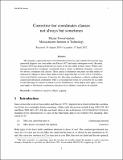| dc.contributor.author | Toosarvandani, Maziar | |
| dc.date.accessioned | 2016-06-27T20:03:45Z | |
| dc.date.available | 2016-06-27T20:03:45Z | |
| dc.date.issued | 2013-06 | |
| dc.date.submitted | 2010-08 | |
| dc.identifier.issn | 0167-806X | |
| dc.identifier.issn | 1573-0859 | |
| dc.identifier.uri | http://hdl.handle.net/1721.1/103362 | |
| dc.description.abstract | The semantic contrast between counterexpectational and corrective but has long interested linguists (see Anscombre and Ducrot 1977 and much subsequent work). Recently, Vicente (2010) has proposed that the two types of but also differ in their syntax. While counterexpectational but coordinates constituents from a variety of different categories, corrective but always coordinates full clauses. These clausal coordination structures are then subject to reduction by ellipsis to derive their surface form. I argue that this clause-only coordination hypothesis is incorrect. Corrective but, like other coordinators, is able to combine both clausal and subclausal constituents. Only a crosscategorial syntax for corrective but accounts for the full range of contexts in which it occurs. Furthermore, when ellipsis does apply, it often must apply to subclausal coordination structures for its identity constraint to be satisfied. | en_US |
| dc.description.sponsorship | Andrew W. Mellon Foundation (New Faculty Fellowship, American Council of Learned Societies) | en_US |
| dc.publisher | Springer Netherlands | en_US |
| dc.relation.isversionof | http://dx.doi.org/10.1007/s11049-013-9198-4 | en_US |
| dc.rights | Article is made available in accordance with the publisher's policy and may be subject to US copyright law. Please refer to the publisher's site for terms of use. | en_US |
| dc.source | Springer Netherlands | en_US |
| dc.title | Corrective but coordinates clauses not always but sometimes | en_US |
| dc.type | Article | en_US |
| dc.identifier.citation | Toosarvandani, Maziar. “Corrective but Coordinates Clauses Not Always but Sometimes.” Nat Lang Linguist Theory 31, no. 3 (June 25, 2013): 827–863. | en_US |
| dc.contributor.department | Massachusetts Institute of Technology. Department of Linguistics and Philosophy | en_US |
| dc.contributor.mitauthor | Toosarvandani, Maziar | en_US |
| dc.relation.journal | Natural Language & Linguistic Theory | en_US |
| dc.eprint.version | Author's final manuscript | en_US |
| dc.type.uri | http://purl.org/eprint/type/JournalArticle | en_US |
| eprint.status | http://purl.org/eprint/status/PeerReviewed | en_US |
| dc.date.updated | 2016-05-23T12:07:23Z | |
| dc.language.rfc3066 | en | |
| dc.rights.holder | Springer Science+Business Media Dordrecht | |
| dspace.orderedauthors | Toosarvandani, Maziar | en_US |
| dspace.embargo.terms | N | en |
| mit.license | PUBLISHER_POLICY | en_US |
| mit.metadata.status | Complete | |
